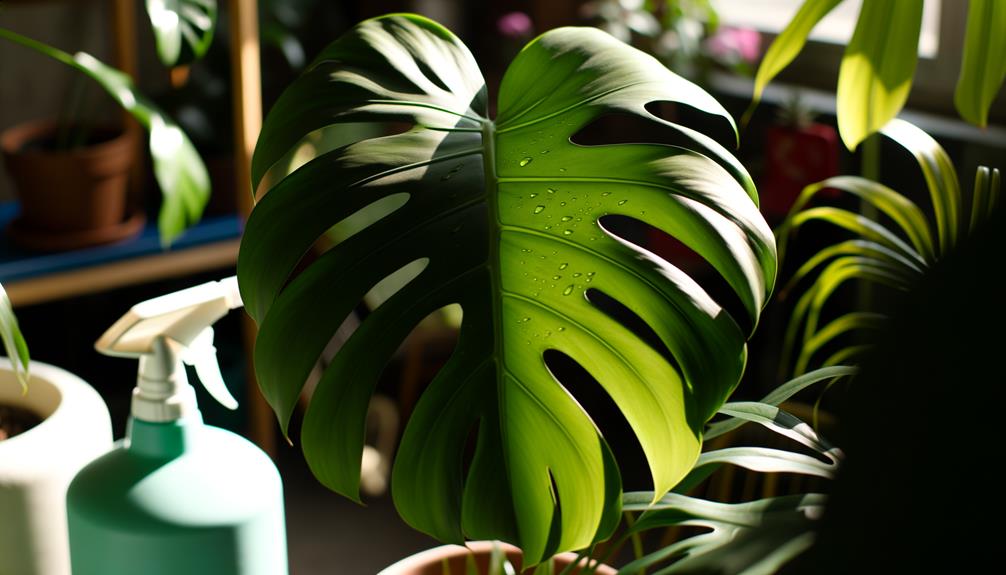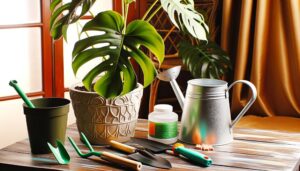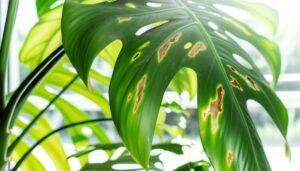Monstera Pinnatipartita Leaf Care
To care for Monstera Pinnatipartita leaves, place them in bright, indirect light, ensuring 12-14 hours daily. Keep humidity between 60%-80% and maintain temperatures from 65°F to 80°F.
Water when the top inch of soil is dry using well-draining, organic-rich soil. Avoid drafts and sudden temperature changes.
Fertilize with a balanced, water-soluble solution bi-weekly during growth seasons. Prune dead or leggy leaves using sterilized tools and regularly check for pests, treating with neem oil or insecticidal soap.
By following these steps, you'll foster lush foliage and vibrant growth. For more intricate details, there's always additional information available.

Key Takeaways
- Place Monstera Pinnatipartita in bright, indirect light and avoid direct sunlight to prevent leaf scorch.
- Maintain soil moisture by watering when the top inch is dry, avoiding waterlogging to prevent root rot.
- Ensure high humidity (60-80%) and optimal temperatures (65-80°F) to prevent leaf browning and yellowing.
- Fertilize with a balanced, water-soluble fertilizer (20-20-20) diluted to half strength every two weeks during the growing season.
- Prune dead or damaged leaves with sterilized tools to promote healthy, fuller growth.
Ideal Lighting Conditions
Ensuring ideal lighting conditions is essential for the healthy growth of Monstera Pinnatipartita leaves. You'll want to place your plant in bright, indirect light. Direct sunlight can scorch the leaves, causing damage.
If natural light is insufficient, consider using full-spectrum grow lights to mimic sunlight. Aim for 12-14 hours of light daily, ensuring a balanced photoperiod. Position the light source 12-18 inches above the plant to avoid heat stress.
Monitor your Monstera for signs of inadequate lighting, such as leggy growth or pale leaves. Adjust positioning and light duration as needed.
Don't forget that consistent light exposure helps maintain the plant's photosynthetic efficiency, promoting robust growth and vibrant foliage.
Watering Requirements
To maintain ideal moisture levels for your Monstera Pinnatipartita, make sure the soil stays consistently damp but not waterlogged.
Water the plant thoroughly when the top inch of soil feels dry to the touch, typically once a week.
Avoid excessive watering, as this can lead to root rot and other fungal problems.
Optimal Moisture Levels
Maintaining the correct moisture levels for your Monstera Pinnatipartita involves watering the soil thoroughly but allowing it to dry out partially between waterings to prevent root rot. Make sure the top 1-2 inches of soil are dry before you water again.
Key considerations include:
- Soil Composition: Use a well-draining mix abundant in organic matter.
- Humidity: Sustain relative humidity around 60-70% to replicate its natural habitat.
- Drainage: Guarantee pots have drainage holes to evade waterlogging.
- Water Quality: Use filtered or rainwater to steer clear of chlorine and fluoride, which can harm the plant.
Frequency and Amount
Monitor the soil's dryness by checking it every few days, aiming to water your Monstera Pinnatipartita once the top 1-2 inches have dried out. Use your finger or a moisture meter for accurate assessment.
When watering, ensure thorough saturation until water drains from the bottom, promoting deep root hydration. Avoid overwatering, as Monstera roots are prone to rot in consistently soggy soil.
Adjust the watering frequency with seasonal changes; reduce watering during winter dormancy and increase during active growth periods in spring and summer. Utilize room-temperature water to prevent shock, and consider using distilled or rainwater to avoid salt buildup from tap water.
Maintaining ideal soil moisture levels is essential for vibrant, healthy foliage.
Humidity Levels
To guarantee your Monstera Pinnatipartita thrives, maintain humidity levels between 60% and 80%.
You can use a humidifier or place a tray of water with pebbles near the plant to achieve this range.
Regularly monitor the humidity with a hygrometer to keep it consistent.
Optimal Humidity Range
A humidity level between 60% and 80% is crucial for the optimal growth and health of your Monstera Pinnatipartita. This tropical plant thrives in environments that mimic its natural rainforest habitat. Maintaining this ideal range ensures strong foliage and prevents issues like leaf browning and stunted growth.
To achieve and monitor the best humidity, consider the following:
- Hygrometer: Invest in a digital hygrometer to accurately measure indoor humidity levels.
- Consistent Mistings: Lightly mist the leaves with distilled water to increase humidity.
- Pebble Trays: Place a tray filled with water and pebbles beneath the plant's pot.
- Room Placement: Position your Monstera away from drafts and direct air conditioning vents.
Humidifying Techniques
Enhancing humidity for your Monstera Pinnatipartita can be effectively achieved through several advanced techniques designed to replicate its natural tropical environment.
First, employ a high-capacity ultrasonic humidifier, which disperses fine mist particles, maintaining ideal leaf turgor pressure. Position the humidifier near the plant but avoid direct contact to prevent excessive moisture buildup.
Additionally, create a humidity tray by placing a layer of pebbles in a shallow dish, filling it with water, and setting your plant pot atop the pebbles. This method utilizes evaporation to increase ambient humidity.
Lastly, consider grouping multiple tropical plants together; their collective transpiration elevates local humidity levels. These techniques guarantee your Monstera Pinnatipartita thrives by mimicking its native habitat's humidity conditions.
Monitoring Humidity Levels
Maintaining ideal humidity levels for your Monstera Pinnatipartita requires regular monitoring to keep conditions within the perfect 60-80% range. Utilize a digital hygrometer for precise readings. Place it near the plant to get accurate humidity levels.
If the humidity falls below 60%, your plant may display signs of stress, such as brown leaf edges or stunted growth. To help maintain peak levels, consider the following:
- Misting: Lightly mist the leaves to boost humidity temporarily.
- Humidifier: Use a humidifier, especially during dry seasons.
- Pebble Tray: Place the pot on a tray filled with water and pebbles.
- Grouping Plants: Cluster plants together to create a microenvironment with higher humidity.
Regular monitoring ensures your Monstera flourishes in its environment.
Temperature Preferences
Monstera pinnatipartita thrives most in temperatures ranging from 65°F to 80°F, ensuring peak growth and leaf development. Maintaining this temperature range is essential, as it mimics their natural tropical habitat.
You should avoid exposing your plant to temperatures below 55°F, as this can cause stress and hinder growth. Sudden temperature fluctuations should also be avoided to prevent leaf damage.
Place your Monstera in a stable environment, away from drafts, vents, and direct airflow from air conditioners or heaters. Consistent monitoring of ambient temperature with a reliable thermometer will help you maintain ideal conditions.
Soil and Potting Mix
Selecting the appropriate soil and potting mix is vital for achieving the best health and growth of your Monstera pinnatipartita. This plant thrives in a well-draining, aerated mix. You should aim for a balance that mimics its natural tropical environment. Here are key components to include:
- Peat moss: Enhances moisture retention without waterlogging the roots.
- Perlite: Improves aeration and drainage, essential for preventing root rot.
- Orchid bark: Adds structure and mimics the plant's epiphytic nature.
- Activated charcoal: Helps in maintaining a fresher, bacteria-free environment.
Mix these elements in equal parts for optimal results. Make sure the pot has drainage holes to prevent water accumulation.
Fertilizing Tips
To nourish your Monstera Pinnatipartita effectively, select a balanced, slow-release fertilizer with a 20-20-20 NPK ratio. Apply it every 4-6 weeks during the growing season, ensuring the soil is moist before feeding.
Always monitor for signs of over-fertilization, such as leaf tip burn or salt buildup, and adjust accordingly.
Choosing Quality Fertilizer
Consistently selecting a balanced, slow-release fertilizer can greatly enhance the growth and overall health of your Monstera Pinnatipartita. You'll want a fertilizer with a balanced N-P-K ratio, such as 10-10-10 or 14-14-14, guaranteeing all essential nutrients are provided equally. Make sure the fertilizer is specifically designed for houseplants to avoid nutrient imbalances.
Additionally, consider these key factors when choosing a quality fertilizer:
- Organic vs. Synthetic: Choose based on your preference for natural ingredients or precise nutrient delivery.
- Micronutrients: Confirm the fertilizer contains essential micronutrients like iron, magnesium, and calcium.
- Formulation: Granules, spikes, or liquid; each has unique benefits for ease of application and nutrient absorption.
- Safety: Opt for non-toxic, pet-safe options if you have pets or children.
Optimal Feeding Schedule
Establishing a consistent feeding timetable is crucial for maximizing your Monstera Pinnatipartita receives the correct nutrients at the right intervals, promoting robust growth and vibrant foliage.
Feed your plant every two weeks during the growth season, typically from spring to early fall. Utilize a balanced, water-soluble fertilizer with an N-P-K ratio of 20-20-20, diluted to half strength. Apply the solution directly to the soil after watering to prevent root burn.
During the dormant period in winter, reduce feeding to once a month or stop entirely, depending on the plant's condition. Regularly assess foliage color and growth rate to adjust the feeding frequency as needed.
This routine ensures your Monstera thrives with top-notch nutrient uptake.
Avoiding Over-Fertilization
Despite the benefits of regular feeding, over-fertilization can lead to nutrient imbalances and root damage, ultimately harming your Monstera Pinnatipartita.
To avoid this, follow these guidelines:
- Dilution: Always dilute the fertilizer to half the recommended strength to prevent nutrient burn.
- Frequency: Fertilize only during the growing season, typically spring and summer, and reduce frequency in fall and winter.
- Soil Testing: Periodically test your soil to monitor nutrient levels and prevent buildup.
- Flush Soil: Every few months, flush the soil with water to remove excess salts.
Pruning and Maintenance
Regular pruning ensures that your Monstera Pinnatipartita remains healthy, promotes strong growth, and maintains an aesthetically pleasing shape. Begin by sterilizing your pruning shears with rubbing alcohol to prevent infections. Focus on removing any dead, yellowing, or damaged leaves. Trim back leggy stems to encourage fuller growth and cut just above a leaf node to stimulate new shoots. Always prune in the growing season for best recovery.
Here's a quick reference table for pruning:
| Task | Details |
|---|---|
| Sterilize tools | Use rubbing alcohol |
| Remove dead leaves | Prevents disease |
| Trim leggy stems | Encourages fuller growth |
| Prune above leaf node | Stimulates new shoots |
Pest Control
Managing pests on your Monstera Pinnatipartita involves identifying common culprits like spider mites, aphids, and mealybugs and employing targeted treatments to guarantee the health of your plant. Start by inspecting leaves regularly for signs of infestation. If you spot pests, act promptly with these interventions:
- Neem Oil: Apply a diluted neem oil solution to leaves, focusing on the undersides.
- Insecticidal Soap: Use an insecticidal soap spray, which effectively suffocates pests without harming your plant.
- Rubbing Alcohol: Dab mealybugs with a cotton swab soaked in rubbing alcohol to dehydrate and kill them.
- Beneficial Insects: Introduce natural predators like ladybugs to control pest populations biologically.
Common Leaf Issues
While maintaining pest control is essential, it's equally important to recognize and address common leaf issues such as yellowing, browning, and leaf drop, which can indicate underlying problems in your Monstera Pinnatipartita's care regimen.
Yellowing leaves often suggest overwatering or nutrient deficiencies. Check the soil's moisture level and guarantee proper drainage. For nutrient deficiencies, consider using a balanced, water-soluble fertilizer.
Browning leaf edges typically point to low humidity or excessive sunlight. Increase humidity using a humidifier and reposition the plant away from direct sunlight.
Leaf drop can result from sudden environmental changes or root rot. Gradually acclimate your Monstera to new conditions and inspect roots for signs of rot, treating promptly if detected.
Propagation Methods
To propagate your Monstera Pinnatipartita, start by selecting a healthy stem with at least one node and aerial root. Using sterilized pruning shears, cut just below the node.
Place the cutting in water or a well-draining soil mix. Make sure the node is submerged or covered to promote root development.
Here are key steps to remember:
- Sterilize Tools: Prevent disease by sanitizing your tools with rubbing alcohol.
- Optimal Conditions: Maintain high humidity and indirect sunlight.
- Monitor Progress: Check for root growth every week.
- Transplanting: Once roots are 2-3 inches long, transfer to soil.
Conclusion
To sum up, caring for your Monstera pinnatipartita isn't rocket science. With the appropriate lighting, watering, humidity, and temperature, it'll thrive like a champ. Remember to use a well-draining soil mix and keep an eye out for pests.
Regular pruning will keep it looking sharp, and propagating can be a fun way to expand your collection. Follow these guidelines and you'll have a healthy, happy plant that's the envy of your neighborhood.
Happy growing!






